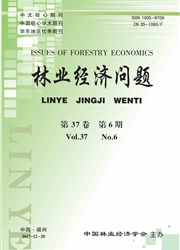

 中文摘要:
中文摘要:
以宁夏自治区盐池县、平罗县、中卫市为样本区域,利用荒漠化生态治理技术模式的调查数据,采用净现值、动态全部投资回收期、内部收益率等林业技术经济模型,对4种荒漠治理生态模式收益率的劳动力价格弹性和敏感性进行测度和比较静态分析,以反映劳动力价格变化对生态治理模式选择的影响。结果表明:⑴调查区的小流域综合治理模式、林草复合生态模式、生态林模式以及封山育林模式都具有较好的内部收益率。⑵不同模式的内部收益率对劳动力价格变动的敏感性具有显著差别。⑶当农村劳动力价格在60元/工时以下,4种模式内部收益率依次为:林草复合模式〉小流域治理模式〉生态林模式〉封山育林模式;当农村劳动力价格提高到70元/工时以上,4种模式的内部收益率排名为:封山育林模式〉生态林模式〉林草复合生态模式〉小流域综合治理模式。⑷选择劳动力投入较少的生态治理模式应成为当前和未来的政策取向,在政策上应该偏向于选择封山育林等劳动力节约型生态治理模式。
 英文摘要:
英文摘要:
Based on the survey data from Yanchi, Pingluo, Zhongwei county in Ningxia province, u-sing the economic input-output data with the net present value, dynamic payback period, internal rate of return and other technical economic methods, we evaluate four desertification combat models and cal-culate the degree of sensitivity of the labor price change. Through comparing the sensitivity, we discuss the impact of labor price change on the desertification combat model selection. Research results suggest that labor prices change will lead to ecological restoration model restructuring, and ecological restoration model with less labor input will be the main selection in the future. Therefore, the policy should be in favor of forest reservation modes and other labor-saving ecological restoration models.
 同期刊论文项目
同期刊论文项目
 同项目期刊论文
同项目期刊论文
 期刊信息
期刊信息
